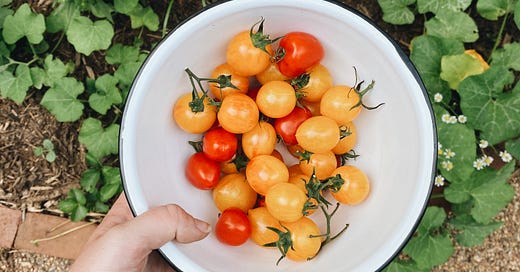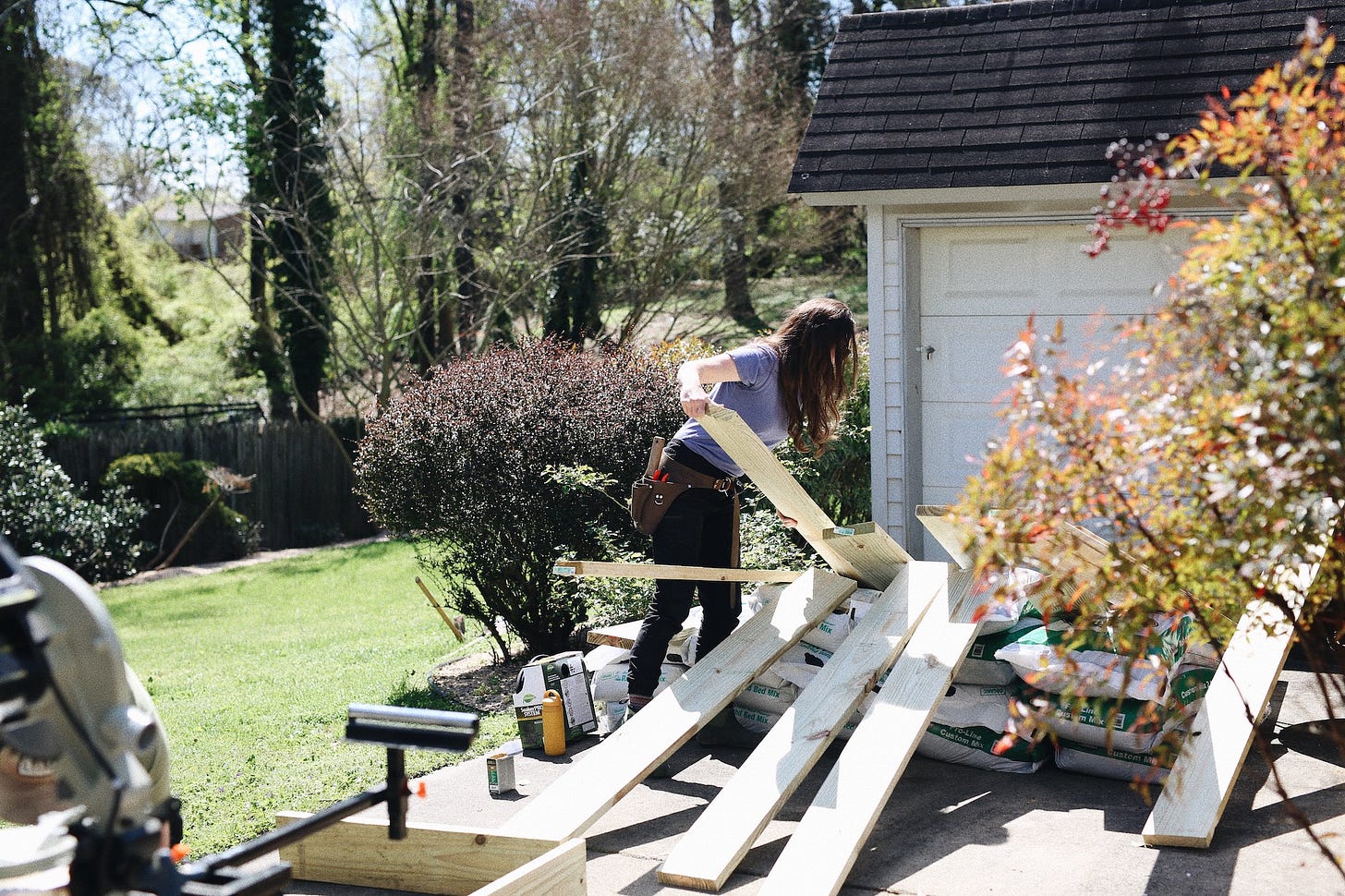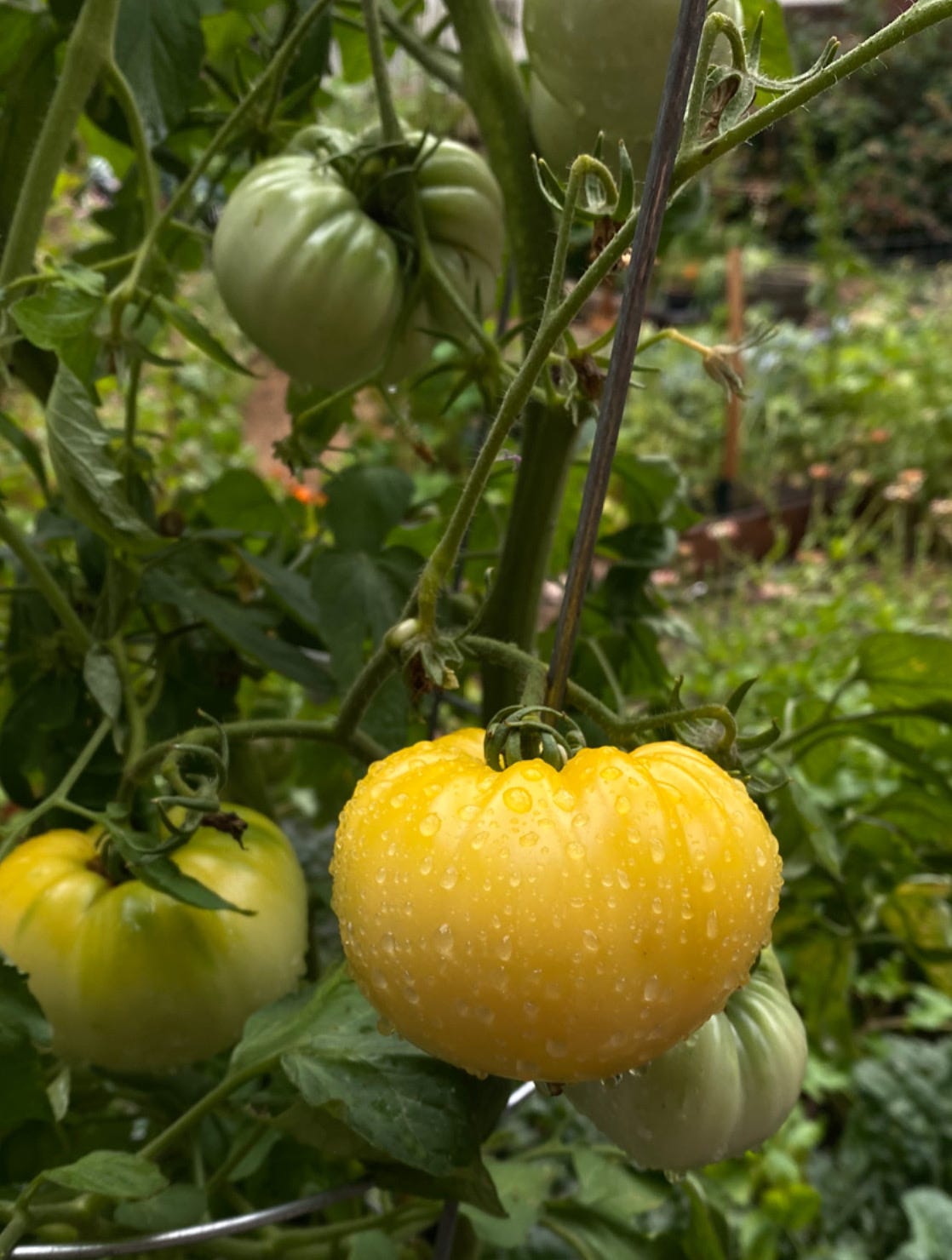🍅 trouble in tomato paradise?
become a fast expert on tomatoes, plus tips + solutions for our favorite summer flavor
Congratulations on making it to April! Despite the cold snap this weekend, it’s really feeling like spring and everyone’s yards feel full of summer promise!
This week, my buddy Will and I started designing, building and installing custom garden beds (more on this later) and it was a great time. Drop me a note if you would like our services. 🛠
I have started selling my vegetable/herb starts and have heard from many customers here in North Carolina that they’ve struggled to grow tomatoes in the past! To me, tomatoes have been the easy constant of both midwestern and southern gardens, despite last year being a universally bad year for tomatoes.
In fact, this is worth considering if you became a gardener during COVID. Plants do have bad years — and the gardener’s skill cannot compete with temps that do not oblige a particular plant’s preference for when it roots, when it fruits, and when it bolts. We cannot control if there is a rare onslaught of late migrating birds or unusual humidity that causes a virus to spread rapidly. Farmers will tell you to give a plant 3 full growing seasons before you give up on it - and I know this sounds like asking to watch 3 full episodes before you give up on a show. But it’s good advice, and I’ve been thankful I didn’t give up on carrots when we had a bad year, or think I couldn’t grow onions!
I hesitated to write about tomatoes today — if you’re a new grower or have never had tomato troubles, read this email with caution. ⚠️ It is an easy plant and I fear this email will imply that they are tricky and particular. I have never found them as such, but there are good care tips regardless. And if you are one of the unfortunates who have struggled, I hope it helps you diagnose the issue!
Lastly, before I give you advice - a few encouraging words to those who don’t like tomatoes and wish they did: Grocery store tomatoes are pretty bad. ☹️ Restaurant tomatoes are even worse. Try a farmer’s market tomato or one from a friend’s yard before you write them off forever - and make sure you try non-standard varieties. The common cherry (to me) is meh, as well as the anonymous globe that sits in the produce aisle. There is an unbelievable spectrum of sweetness, tartness, softness, firmness, water content, and general mouthfeel. And, the fresher the better. A same-day tomato and week-old tomato are not the same food item.
When it comes to falling in love with tomatoes, heirlooms get the most praise, but this is a grouping of varieties — not an actual variety! There are over 3000 varieties of heirlooms in active cultivation, which leads me to my first tip: Grow heirloom varieties that are cultivated for your region. These are bred for your weather, your soil, your pests, and your viruses. They are more flavorful and have the same nuances and breadth of flavor profiles that chefs recognize in different wines or cheeses.
UNDERSTANDING TOMATOES 🤔
I also would like to outline a few basic categories that divide the 15,000+ cultivars of tomatoes. Understanding these terms will help you navigate your future with them.
Heirloom, Hybrid, or Open Pollinated.
Heirloom(or heritage) tomatoes are varieties that have existed for 50+ years and have not been crossbred or meddled with for large scale production. Unlike what you find in grocery stores, these are native to a specific region and typically passed down for flavor and sturdiness. If you grow an heirloom variety, you can harvest and save the seeds from this tomato and it will re-grow the following year.Hybridsare crossbred in greenhouses or controlled environments, typically by large seed companies that aim to find traits that make them profitable and shippable: fast to mature, resistant to as many diseases as possible, and produce a fruit that is easy to ship and store for long periods of time. Honestly, these are not bad traits — but flavor is usually the first one to be lost in the process. And, if you try to save seeds from these tomatoes, you won’t know what traits from its grandparents it will inherit. You may get something similar, or not at all.Open Pollinatedare basically young, future Heirlooms. They aren’t bred in a lab, and they pollinate naturally and produce the same fruit generation after generation - just like Heirlooms. If a breeder continues to grow their Open Pollinated variety for 50+ years, it is considered an Heirloom.
Tomato Shapes: Cherry, Plum, Globe, Beefsteak and Oxheart. Most of us attribute the beefsteak shape to heirlooms, but there are heirloom varieties of ALL of these! There are additional categories inside of each (for example: There are tiny plums that are quite sweet, Italian plums that are best for paste, San Marzano plums which have notoriety, and Roma plums which are the best for canning) but we tend to know their purpose. Cherries are made for summer salads and roasting, plums are for cooking, and globes, beefsteaks, and oxhearts for slicing. I am convinced there is a variety of each shape for everyone, no matter your preference.
Determinate vs Indeterminate:
Determinatetomatoes have a “determined” small size (usually 2-4’). They all fruit and ripen within a ~2 week time period, and then it’s done. We call these bush tomatoes, container tomatoes, or just non-vining tomatoes.Indeterminatetomatoes are “indetermined” (not a word, I know) as to how tall they will grow. These can grow 8-12’ tall, need heavy staking or trellising, and produce tomatoes consistently until frost. You can harvest for a long time. These two growth styles exists within beans, peas, and potatoes too.
OKAY HOW DO I MAKE A TOMATO HAPPY?? 🤗
Happy Temps: Their fav daytime temp is 70-80°, and fav nighttime temp is 60-70°. They don’t die over 80°, but this is when you could see some issues. Days hotter than 86° can sterilize the pollen, so the idea is to try to get a good batch of tomatoes before temps stay in the 90s consistently. You have to plant them after the last spring freeze, so you have three good options: (1) Start tomato seeds early inside, repot often, and transplant (or buy) as large of a start as possible after the last frost, (2) Choose varieties with very fast maturation periods, like 50-65 days rather than 90-100 days, or (3) Choose heirloom varieties for your region that are known to withstand high temps. Don’t give up if your tomato struggles in the throws of summer; my tomatoes always begin producing again once it cools down.
Happy Sunlight: Tomatoes need 8+ hours of sunlight every day. They are not a shade plant, and won’t create enough energy to fruit without full sun. If you don’t have consistent sunlight in one location, I really suggest growing determinate varieties in pots and moving them around!
Happy Roots: The larger a root system, the healthier the plant. Well-developed root systems find more water and nutrients, and store more water and nutrients. All of this helps survive heat, dry spells, wet spells, pests, and diseases. Deep-plant your tomatoes to double or triple the root system, and follow no-till methods. Tilling soil disturbs mychorrizal fungi that acts as an extension of the roots of plants.
Happy Friends: Tomatoes need companion plants to help ward off aphids and other bad insects. My favorites are basil, parsley, marigolds and nasturtium - and this year I’ll be trying borage. Things that stay short (parsley, marigold, nasturtium) can be planted within a few inches around a tomato and live in the “understory” of a tomato, providing a pest barrier. Try to densely plant your herbs and marigolds - just 1 in a bed won’t cut it.
Happy Neighborhood: Select 2-4 varieties of tomatoes to increase your chance of success each year. And put them in different areas of your garden! If one tomato gets a virus, it’s less likely to spread to the rest.
Happy Food: Tomatoes do use a lot of nutrients to grow, so I recommend fertilizing with a standard vegetable organic mix every 2-3 weeks — less often in more clay-y soil. (Clay holds nutrients longer.) Don’t overdo it though; more will work against you.
Happy Blossoms: Tomatoes self-pollinate, meaning each flower has both male and female parts — but having lots of pollinator plants to attract additional insects is great. The pollen still needs to be jostled, so insects and wind help.
Happy Fruits: If your plant creates tomatoes but they are rotting on the bottom (blossom side), this is called blossom-end rot. It happens when the plant isn’t absorbing calcium. You either HAVE calcium in the soil but the plant can’t access it, OR there is not enough calcium present. Some things to try:
Your dirt could be too acidic to absorb it. Target pH is 6.5-6.7. If you are planting in a new raised bed with high quality dirt, this shouldn’t be an issue. But, if it’s an in-ground bed in the SE, you likely need to lime your soil to pull the naturally acidic dirt up a bit.
Fertilizing too much. Calcium competes with other nutrients for access into the plant’s roots, so if you’ve added too much Nitrogen, Phosphorus or Potassium, Calcium may get the cold shoulder. Don’t fertilize for several weeks and water heavily to help extra nutrients leach out of the soil.
Mulch. This will help retain moisture and keep the plant from experiencing stress.
Add calcium. Yes, you can try eggshells and epsom salt, but to guarantee a fast solution, get a calcium nitrate product. Hi-Yield is at most local hardware stores and well-stocked nurseries. (Ace Hardware, ABSeed, etc)
TIPS
Other good care practices to follow!
Completely remove tomato vines from your property at the end of the year. Verticillium Wilt is a relentless fungus that lives in the soil and in the vines of a plant. Remove the plant + roots at the end of each year and do not compost them. This will help control the fungus if you have it, and also keep pest eggs from hibernating all winter.
Stake them properly - and before they need it. I have wasted so much money buying the little stakes, thin stakes, cheap stakes. Just get a couple high quality, high gauge stakes or cages and plan to use them for years to come.
Try growing in pots. Tomatoes are one of the best plants to grow in containers. Get a large pot and go for it! Pick a determinate/bush variety and enjoy your cutie fruities. Craig LeHoullier [Epic Tomatoes author] grows 2000lbs+ of tomatoes in containers in his driveway every year.
Pick your suckers [on indeterminates]. This is fun in the spring and then can really get away from you by late summer, but make it a 2x/week habit to cut off suckers. You want strong, primary vines to produce and carry your tomatoes, and to eliminate the small weak offshoots that take up the plants nutrients and turn your bed into a #hotmess. *Not relevant to determinate/bush plants.
Mulch mulch mulch. Mulch your tomatoes heavily (2-4”) - this will control the temperature and moisture of the soil, and keep fungus and diseases from splashing up into the plant leaves when it rains.
Trim leaves/shoots at the base of the plant. For indeterminate (tall) tomatoes, once they’re about 3 feet in size, cut off the leaves closest to the ground. You want to minimize the risk of disease splashing up onto leaves, and from pests easily making it up the plant. I try to keep about a foot of space between the ground and the lowest “branches” on adult tomato plants, and it’s served me well.
Be patient during heat waves. When it’s 90s during the day and 80s at night, expect your tomatoes to go on pause. The pollen can sterilize and the humidity can clog the pollen. Keep the tomato well watered and wait it out. Don’t give up!
RECOMMENDED VARIETIES FOR THE SOUTHEAST
Heirlooms: ‘German Johnson’, ‘Arkansas Traveler, ‘Cherokee Purple’, ‘Black Plum,’ ‘Solar Flare,’ and ‘Homestead.’ I’ve also had exceptional success with ‘Sunrise Bumblebee.’
Hybrids: ‘Celebrity’, ‘Early Girl’ and ‘Better Boy’ are bred to tolerate heat and common viruses
Everything by Southern Exposure should be great for our region. Have fun exploring!
Alright my friends, that concludes today’s tomato journey. 🍅 If you do not live in the Southeast - do not fear! Just search “best heirloom tomato varieties for Zone [your zone]” — and I always recommend adding site:edu to any search. This will give you only academic results, and help you avoid poor information. ✅
🌿 UPCOMING PLANT SALE 🌿 Sunday, April 24th from 12-4pm at Fancy Groceries. I will have Cherokee Purple, Sunrise Bumblebee, Great White, and Brandywine tomatoes as well as Feverfew, Nasturtiums, Zinnias, Basil, Kale, Strawberries, Borage and more.
👾 OPEN OFFICE HOURS 👾 Our first virtual open office hours were so fun. I hop onto video chat on Thursdays at 12pm and 6pm EST to hang out + answer questions + help garden plan, troubleshoot, or help with decisions. Like a little garden club, for our paid subscribers. More info + how to join here.
Enjoy your lovely week ahead -
Lauren 🌻
















